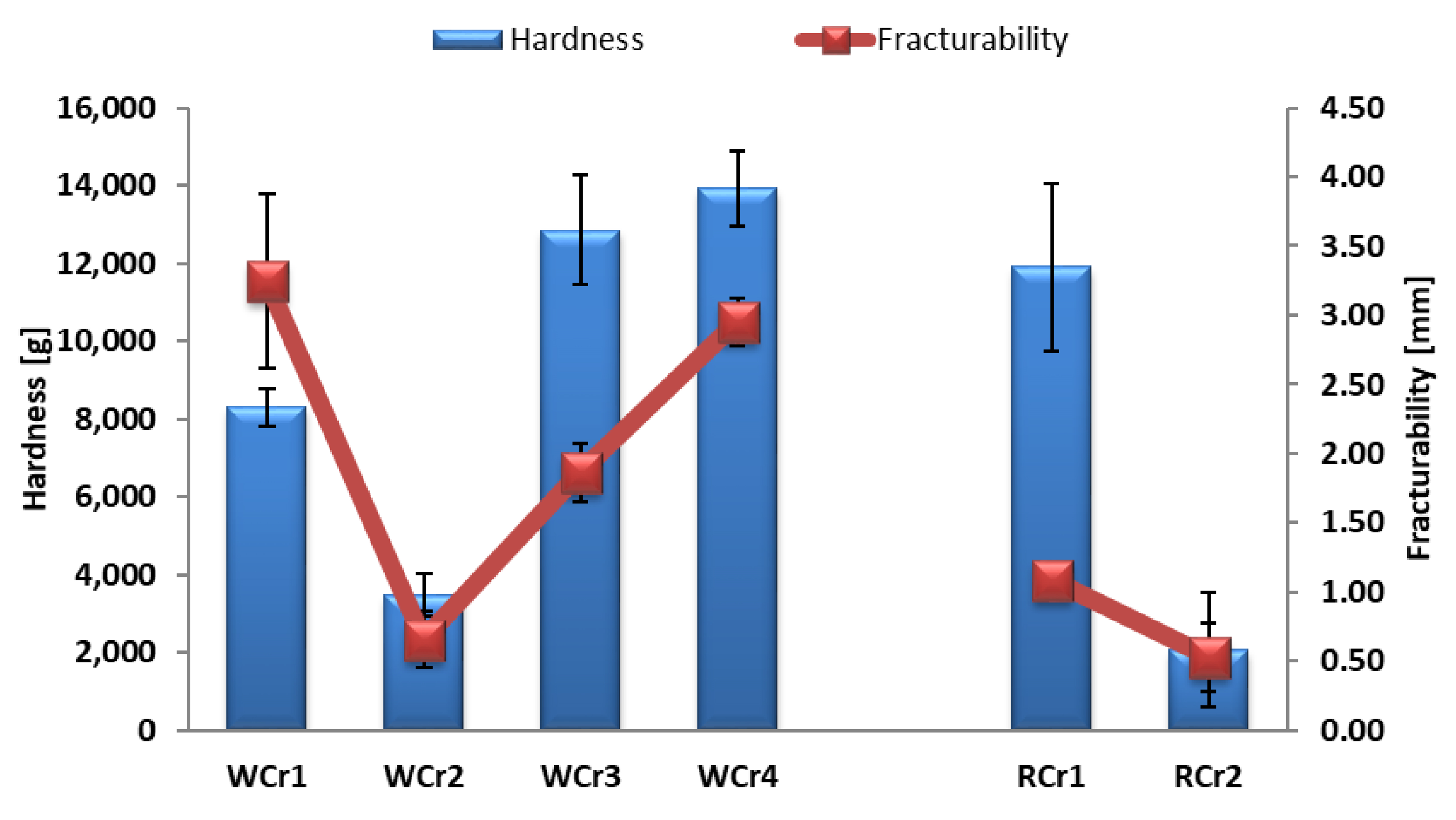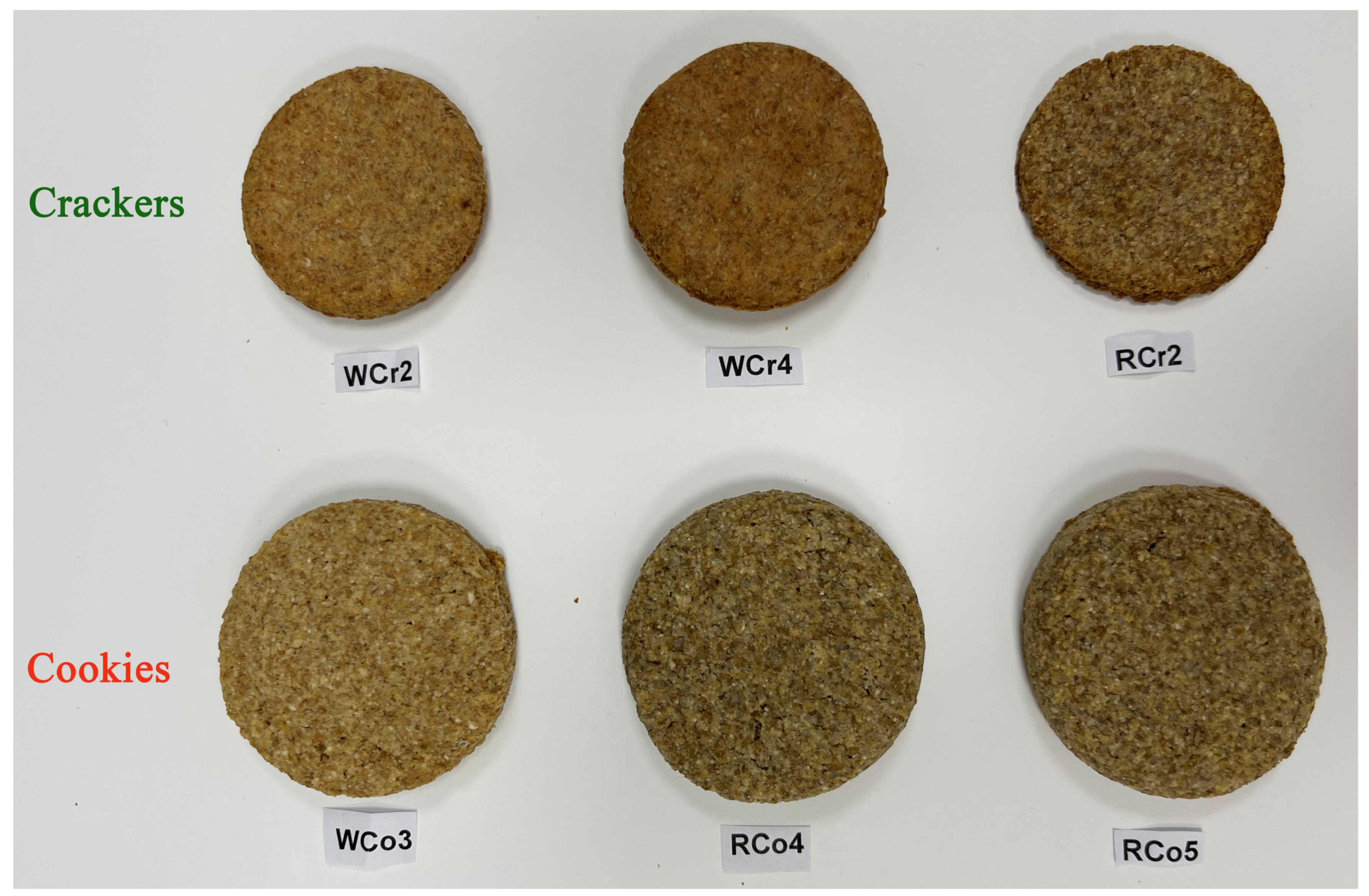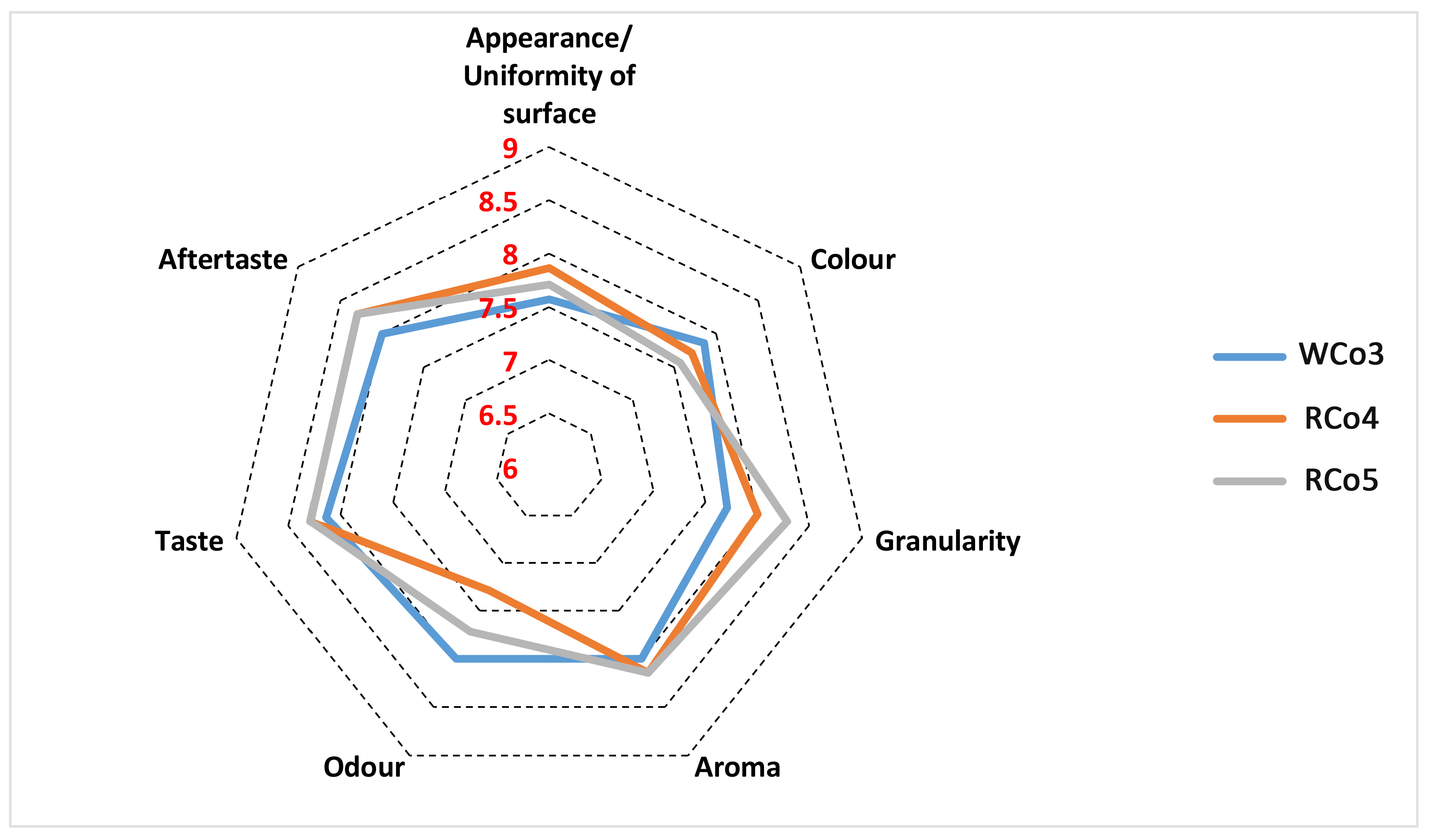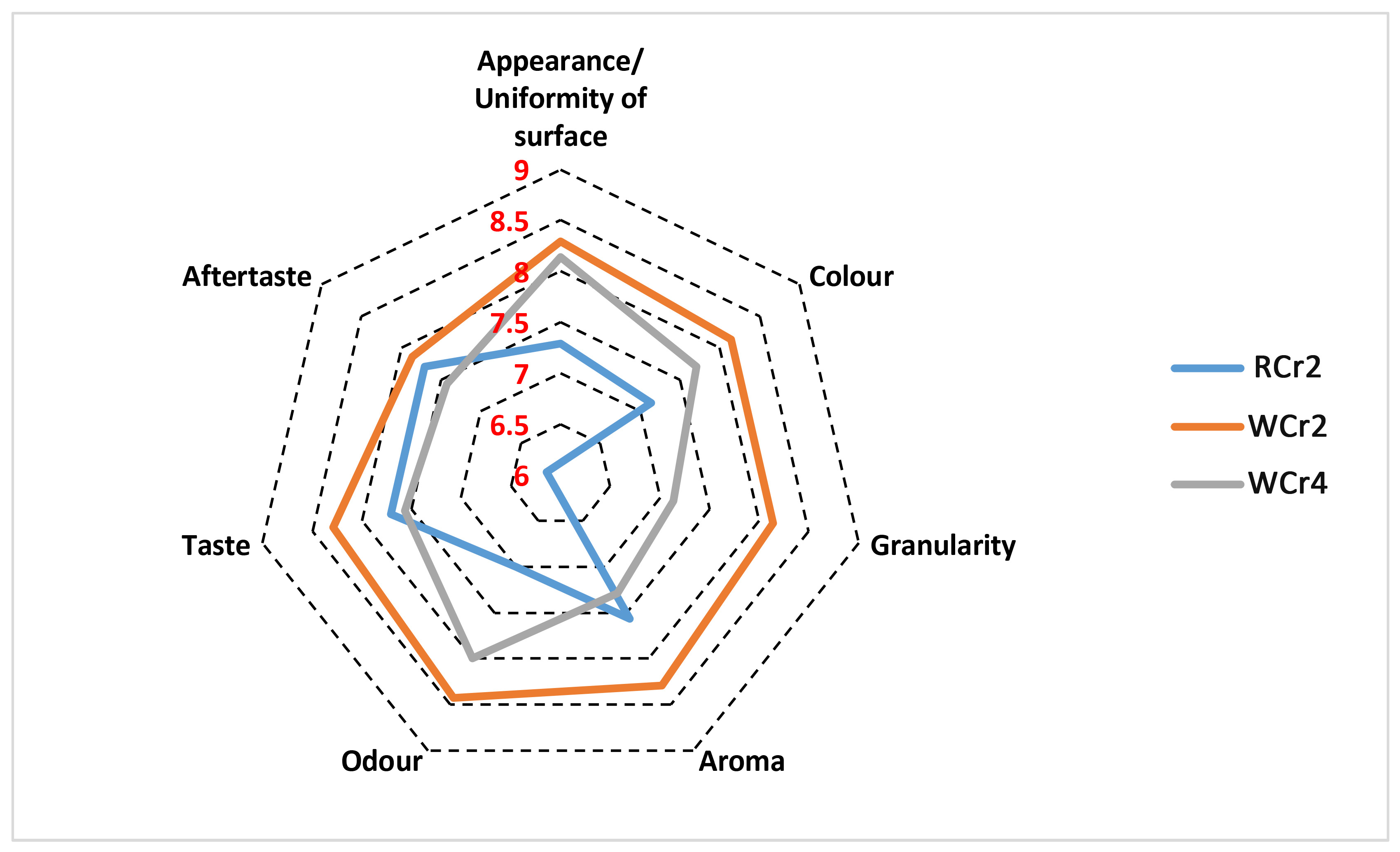Biotechnological Tools for the Production of Low-FODMAP Wholegrain Wheat and Rye Cookies and Crackers
Abstract
1. Introduction
2. Materials and Methods
2.1. Materials
2.2. Production of Chicory Extract
2.3. Production of Wheat Malt
2.4. Cookie Preparation Procedure
2.5. Cracker Preparation Procedure
2.6. Quantification of FODMAPs Using HPAEC-PAD Method
2.7. Total Fructans
2.8. Textural Properties
2.9. Sensory Analyses
2.10. Statistical Analyses
3. Results and Discussion
3.1. FODMAP Compounds Reduction During Creation of Cookies and Crackers
3.2. Texture Properties of Wholegrain Crackers and Cookies
3.3. Sensory Profile of Cookies and Crackers
4. Conclusions
Author Contributions
Funding
Institutional Review Board Statement
Informed Consent Statement
Data Availability Statement
Conflicts of Interest
References
- Dieterich, W.; Zopf, Y. Gluten and FODMAPS—Sense of a Restriction/When Is Restriction Necessary? Nutrients 2019, 11, 1957. [Google Scholar] [CrossRef]
- Morariu, I.-D.; Avasilcai, L.; Vieriu, M.; Lupu, V.V.; Morariu, B.-A.; Lupu, A.; Morariu, P.-C.; Pop, O.-L.; Starcea, I.M.; Trandafir, L. Effects of a Low-FODMAP Diet on Irritable Bowel Syndrome in Both Children and Adults—A Narrative Review. Nutrients 2023, 15, 2295. [Google Scholar] [CrossRef] [PubMed]
- Torbica, A.; Radosavljević, M.; Belović, M.; Tamilselvan, T.; Prabhasankar, P. Biotechnological tools for cereal and pseudocereal dietary fibre modification in the bakery products creation–Advantages, disadvantages and challenges. Trends Food Sci. Technol. 2022, 129, 194–209. [Google Scholar] [CrossRef]
- Bertin, L.; Zanconato, M.; Crepaldi, M.; Marasco, G.; Cremon, C.; Barbara, G.; Barberio, B.; Zingone, F.; Savarino, E.V. The Role of the FODMAP Diet in IBS. Nutrients 2024, 16, 370. [Google Scholar] [CrossRef]
- Zeeshan, M.H.; Vakkalagadda, N.P.; Sree, G.S.; kishore Anne, K.; Parkash, O.; Fawwad, S.B.U.; Haider, S.M.W.; Mumatz, H.; Hasan, M. Irritable bowel syndrome in adults: Prevalence and risk factors. Ann. Med. Surg. 2022, 81, 104408. [Google Scholar] [CrossRef]
- Laatikainen, R.; Jalanka, J.; Loponen, J.; Hongisto, S.M.; Hillilä, M.; Koskenpato, J.; Korpela, R.; Salonen, A. Randomised clinical trial: Effect of low-FODMAP rye bread versus regular rye bread on the intestinal microbiota of irritable bowel syndrome patients: Association with individual symptom variation. BMC Nutr. 2019, 5, 12. [Google Scholar] [CrossRef]
- Atzler, J.J.; Sahin, A.W.; Gallagher, E.; Zannini, E.; Arendt, E.K. Characteristics and properties of fibers suitable for a low FODMAP diet—An overview. Trends Food Sci. Technol. 2021, 112, 823–836. [Google Scholar] [CrossRef]
- Ispiryan, L.; Zannini, E.; Arendt, E.K. FODMAP modulation as a dietary therapy for IBS: Scientific and market perspective. Compr. Rev. Food Sci. Food Saf. 2022, 21, 1491–1516. [Google Scholar] [CrossRef]
- Mezzomo, T.R.; Sampaio, I.R.; Fiori, L.S.; Schieferdecker, M.E.M. Content of poorly absorbed short-chain carbohydrates (FODMAP) in enteral homemade diets. Nutr. Clin. Pract. 2019, 34, 264–271. [Google Scholar] [CrossRef]
- Loponen, J.; Gänzle, M.G. Use of sourdough in low FODMAP baking. Foods 2018, 7, 96. [Google Scholar] [CrossRef] [PubMed]
- Acín Albiac, M.; Di Cagno, R.; Filannino, P.; Cantatore, V.; Gobbetti, M. How fructophilic lactic acid bacteria may reduce the FODMAPs content in wheat-derived baked goods: A proof of concept. Microb. Cell Factories 2020, 19, 182. [Google Scholar] [CrossRef] [PubMed]
- Oka, P.; Parr, H.; Barberio, B.; Black, C.J.; Savarino, E.V.; Ford, A.C. Articles Global prevalence of irritable bowel syndrome according to Rome III or IV criteria: A systematic review and meta-analysis. Lancet Gastroenterol. Hepatol. 2020, 5, 908–917. [Google Scholar] [CrossRef]
- Gawade, D.S.; Patil, K.W.; Jayram, G.H. Development of value-added cookies supplemented with giloy and tulsi powder. Mater. Today Proc. 2023, 73, 530–534. [Google Scholar] [CrossRef]
- Mrabet, A.; Hamdi, A.; Rodríguez-Arcos, R.; Guillén-Bejarano, R.; Jiménez-Araujo, A. Date seed by-products as source of bioactive ingredient for healthy cookies. Food Biosci. 2024, 61, 104543. [Google Scholar] [CrossRef]
- Karunanithi, S.; Guha, P.; Srivastav, P.P. Valorization of betel leaves byproducts: A novel ingredient for sustainable cookie development. Food Chem. Adv. 2024, 5, 100799. [Google Scholar] [CrossRef]
- Koc, F.; Atzler, J.; Sahin, A.W.; Arendt, E.; Ross, R.P.; Stanton, C. Biscuits for the gut: A symphony of FODMAPs and dietary fibre in gut microbiome for irritable bowel syndrome (IBS) management. Innov. Food Sci. Emerg. Technol. 2024, 97, 103832. [Google Scholar] [CrossRef]
- Batista, A.P.; Niccolai, A.; Bursic, I.; Sousa, I.; Raymundo, A.; Rodolfi, L.; Biondi, N.; Tredici, M.R. Microalgae as Functional Ingredients in Savory Food Products: Application to Wheat Crackers. Foods 2019, 8, 611. [Google Scholar] [CrossRef]
- Radoš, K.; Čukelj Mustač, N.; Varga, K.; Drakula, S.; Voučko, B.; Ćurić, D.; Novotni, D. Development of High-Fibre and Low-FODMAP Crackers. Foods 2022, 11, 2577. [Google Scholar] [CrossRef] [PubMed]
- Jiménez-Pulido, I.J.; Rico, D.; Martinez-Villaluenga, C.; Pérez-Jiménez, J.; Luis, D.D.; Martín-Diana, A.B. Sprouting and Hydrolysis as Biotechnological Tools for Development of Nutraceutical Ingredients from Oat Grain and Hull. Foods 2022, 11, 2769. [Google Scholar] [CrossRef] [PubMed]
- Krivorotova, T.; Sereikaite, J. Determination of fructan exohydrolase activity in the crude extracts of plants. Electron. J. Biotechnol. 2014, 17, 329–333. [Google Scholar] [CrossRef]
- Krstanović, V.; Habschied, K.; Dvojković, K.; Mastanjević, K. Research on the Malting Properties of Domestic Wheat Varities. Fermentation 2020, 7, 1. [Google Scholar] [CrossRef]
- Weitzhandler, M.; Barreto, V.; Pohl, C.; Jandik, P.; Cheng, J.; Avdalovic, N. CarboPac™ PA20: A new monosaccharide separator column with electrochemical detection with disposable gold electrodes. J. Biochem. Bioph. Meth. 2004, 60, 309–317. [Google Scholar] [CrossRef]
- Ispiryan, L.; Heitmann, M.; Hoehnel, A.; Zannini, E.; Arendt, E.K. Optimization and validation of an HPAEC-PAD method for the quantification of FODMAPs in cereals and cereal-based products. J. Agric. Food Chem. 2019, 67, 4384–4392. [Google Scholar] [CrossRef] [PubMed]
- ISO 8589:2007; Sensory Analysis—General Guidance for the Design of Test Rooms. ISO: Geneva, Switzerland, 2015.
- Nyyssölä, A.; Nisov, A.; Lille, M.; Nikinmaa, M.; Rosa-Sibakov, N.; Ellilä, S.; Valkonen, M.; Nordlund, E. Enzymatic reduction of galactooligosaccharide content of faba bean and yellow pea ingredients and food products. Future Foods 2021, 4, 100047. [Google Scholar] [CrossRef]
- EatforHealth.gov.au. Available online: https://www.eatforhealth.gov.au/food-essentials/how-much-do-we-need-each-day/serve-sizes (accessed on 10 December 2024).
- European Snack Association. Available online: https://www.esasnacks.eu/PDF/PortionSize2019.pdf (accessed on 10 December 2024).
- Food and Nutrition—Canada. Available online: https://www.canada.ca/en/health-canada/services/technical-documents-labelling-requirements/table-reference-amounts-food/nutrition-labelling.html#a (accessed on 10 December 2024).
- Food-Based Dietary Guidelines Recommendations for Starchy Foods. Available online: https://knowledge4policy.ec.europa.eu/health-promotion-knowledge-gateway/food-based-dietary-guidelines-europe-table-1_en (accessed on 10 December 2024).
- U.S. Food & Drug Administration. Available online: https://www.accessdata.fda.gov/scripts/cdrh/cfdocs/cfcfr/CFRSearch.cfm?fr=101.12 (accessed on 10 December 2024).
- Biesiekierski, J.R.; Rosella, O.; Rose, R.; Liels, K.; Barrett, J.S.; Shepherd, S.J.; Gibson, P.R.; Muir, J.G. Quantification of fructans, galacto-oligosacharides and other short-chain carbohydrates in processed grains and cereals. J. Hum. Nutr. Diet. 2011, 24, 154–176. [Google Scholar] [CrossRef] [PubMed]
- Ribeiro, M.; Ferreira, D.; Siopa, J.; Rodriguez-Quijano, M.; Nunes, F.M. Natural variation in the content and degree of polymerization of fructans in wheat: Potential for selection of genotypes with beneficial health composition. J. Agr. Food Chem. 2022, 70, 10929–10939. [Google Scholar] [CrossRef]
- Lovell, R.M.; Ford, A.C. Effect of Gender on Prevalence of Irritable Bowel Syndrome in the Community: Systematic Review and Meta-Analysis. Am. J. Gastroenterol. 2012, 107, 991–1000. [Google Scholar] [CrossRef]
- Struyf, N.; Laurent, J.; Verspreet, J.; Verstrepen, K.J.; Courtin, C.M. Saccharomyces cerevisiae and Kluyveromyces marxianus cocultures allow reduction of fermentable oligo-, di-, and monosaccharides and polyols levels in whole wheat bread. J. Agr. Food Chem. 2017, 65, 8704–8713. [Google Scholar] [CrossRef]
- Martins, G.N.; Ureta, M.M.; Tymczyszyn, E.E.; Castilho, P.C.; Gomez-Zavaglia, A. Technological aspects of the production of fructo and galacto-oligosaccharides. Enzymatic synthesis and hydrolysis. Front. Nutr. 2019, 6, 78. [Google Scholar] [CrossRef]
- Rópolo, A.S.; Feliziani, C.; Touz, M.C. Chapter One-Unusual proteins in Giardia duodenalis and their role in survival. In Advances in Parasitology; Ortega-Pierres, M.G., Ed.; Academic Press: Cambridge, MA, USA, 2019; pp. 1–50. [Google Scholar] [CrossRef]
- Nyyssölä, A.; Ellilä, S.; Nordlund, E.; Poutanen, K. Reduction of FODMAP content by bioprocessing. Trends Food Sci. Technol. 2020, 99, 257–272. [Google Scholar] [CrossRef]
- Nilsson, U.; Öste, R.; Jägerstad, M. Cereal fructans: Hydrolysis by yeast invertase, in vitro and during fermentation. J. Cereal Sci. 1987, 6, 53–60. [Google Scholar] [CrossRef]
- Sahin, A.W.; Atzler, J.J.; Crofton, E.; Gallagher, E.; Zannini, E.; Walter, J.; Arendt, E.K. Impact of different fibre ingredients on a low-FODMAP biscuit model system. Food Funct. 2023, 14, 7082–7095. [Google Scholar] [CrossRef] [PubMed]
- Jribi, S.; Sahagún, M.; Belorio, M.; Debbabi, H.; Gomez, M. Effect of sprouting time on dough and cookies properties. J. Food Meas. Charact. 2020, 14, 1595–1600. [Google Scholar] [CrossRef]
- Ivanišová, E.; Drevková, B.; Tokár, M.; Terentjeva, M.; Krajčovič, T.; Kačániová, M. Physicochemical and sensory evaluation of biscuits enriched with chicory fiber. Food Sci. Technol. Int. 2020, 26, 38–43. [Google Scholar] [CrossRef]





| COOKIES | |||||||||
|---|---|---|---|---|---|---|---|---|---|
| Wholegrain Wheat | Wholegrain Rye | ||||||||
| % Relative to Amount of Flour | WCo1 | WCo2 | WCo3 | RCo1 | RCo2 | RCo3 | RCo4 | RCo5 | |
| 1. | Wholegrain wheat flour | 100 | 100 | 70 | 0 | 0 | 0 | 0 | 0 |
| 2. | Wholegrain rye flour | 0 | 0 | 0 | 100 | 100 | 95 | 95 | 95 |
| 3. | Malt | 0 | 0 | 30 * | 0 | 0 | 5 * | 5 * | 5 |
| 4. | Water | 31.2 | 31.2 | 31.2 | 20 | 20 | 20 | 20 | 20 |
| 5. | Sucrose | 20 | 20 | 20 | 28 | 28 | 28 | 28 | 28 |
| 6. | Salt | 1 | 1 | 1 | 1.1 | 1.1 | 1.1 | 1.1 | 1.1 |
| 7. | Shortening | 20 | 20 | 20 | 32 | 32 | 32 | 32 | 32 |
| 8. | Sodium hydrogen carbonate | 0.5 | 0.5 | 0.5 | 0.4 | 0.4 | 0.4 | 0.4 | 0.4 |
| 9. | Ammonium hydrogen carbonate | 0.5 | 0.5 | 0.5 | 0.2 | 0.2 | 0.2 | 0.2 | 0.2 |
| Conditions | |||||||||
| 1. | Mixing 1 (min) | 5 | 5 | 5 | 5 | 5 | 5 | 5 | 5 |
| 2. | Resting 1 (min) | 20 | 90 | 90 | 20 | 90 | 90 | 120 | 150 |
| 3. | Mixing 2 (min) | 0 | 5 | 5 | 0 | 5 | 5 | 5 | 5 |
| 4. | Resting 2 (min) | 0 | 20 | 20 | 0 | 20 | 20 | 20 | 20 |
| 5. | T (°C) | 30 | 30 | 30 | 30 | 30 | 30 | 30 | 30 |
| 6. | T baking (°C) | 180 | 180 | 180 | 180 | 180 | 180 | 180 | 180 |
| 7. | Time of baking (min) | 15 | 15 | 15 | 15 | 15 | 15 | 15 | 15 |
| CRACKERS | |||||||
|---|---|---|---|---|---|---|---|
| Wholegrain Wheat | Wholegrain Rye | ||||||
| % Relative to Amount of Flour | WCr1 | WCr2 | WCr3 | WCr4 | RCr1 | RCr2 | |
| 1. | Wholegrain wheat flour | 100 | 100 | 100 | 70 | 0 | 0 |
| 2. | Wholegrain rye flour | 0 | 0 | 0 | 0 | 100 | 100 |
| 3. | Malt | 0 | 0 | 0 | 30 * | 0 | 0 |
| 4. | Water | 51.2 | 0 | 51.2 | 51.2 | 53.6 | 53.6 |
| 5. | Extract | 0 | 51.2 | 0 | 0 | 0 | 0 |
| 6. | Sucrose | 5 | 5 | 5 | 5 | 0 | 0 |
| 7. | Salt | 1.5 | 1.5 | 1.42 | 1.42 | 1.6 | 1.42 |
| 8. | Shortening | 11 | 11 | 12.5 | 12.5 | 10 | 12.5 |
| 9. | Sodium bicarbonate | 0.55 | 0.55 | 0.25 | 0.25 | 0.55 | 0.25 |
| 10. | Ammonium bicarbonate | 2.5 | 2.5 | 0 | 0 | 0 | 0 |
| 11. | Fresh baker’s yeast | 0 | 0 | 1.83 | 1.83 | 0 | 1.83 |
| Conditions | |||||||
| 1. | Mixing 1 (min) | 5 | 5 | 5 | 5 | 5 | 5 |
| 2. | Resting 1 (min) | 20 | 90 | 180 | 90 | 20 | 180 |
| 3. | Mixing 2 (min) | 5 | 5 | 1 | 5 | 5 | 1 |
| 4. | Resting 2 (min) | 0 | 20 | 20 | 180 | 0 | 20 |
| 5. | Mixing 3 (min) | 0 | 0 | 0 | 1 | 0 | 0 |
| 6. | Resting 3 (min) | 0 | 0 | 0 | 20 | 0 | 0 |
| 7. | T resting/fermentation (°C) | 30 | 40 | 30 | 30 | 30 | 30 |
| 8. | T baking (°C) | 220 | 220 | 220 | 220 | 220 | 220 |
| 9. | Time of baking (min) | 13 | 13 | 13 | 13 | 13 | 13 |
| Sensory Attribute | Description |
|---|---|
| Appearance/Uniformity of surface | Uniform–non-uniform/smooth–rough |
| Colour | Degree of brownness, ranging from light brown to dark brown |
| Granularity | Sense of particle size and shape (larger particles–higher granularity) |
| Aroma | Olfactory perceptions caused by volatile substances released from a product in the mouth via the posterior nares |
| Odour | Overall intensity of odour (volatiles are sniffed through nose) |
| Taste | Overall intensity of taste (gustatory perceptions caused by soluble substances in mouth) |
| Aftertaste | Gustatory–olfactory sensation left in mouth after sample is swallowed or spat out (persistence of flavour after the stimulating agent has gone), perceived as a positive characteristic |
| COOKIES | CRACKERS | ||
| Serving size | 30 g | 30 g | |
| FODMAP | COOKIES | CRACKERS | |
| Cut-off values | g per serving | g/100 g “as is” | |
| Fructose in excess of glucose | <0.15 | <0.5 | <0.5 |
| Total oligosaccharides (fructans and galactooligosaccharides) | <0.3 | <1 | <1 |
| Total polyoles | <0.4 (or <0.2 mannitol or sorbitol) | 1.33 (0.67) | 1.33 (0.67) |
| Lactose | <1 | <3.33 | <3.33 |
| Wholegrain Wheat COOKIES | Wholegrain Rye COOKIES | |||||||
|---|---|---|---|---|---|---|---|---|
| WCo1 | WCo2 | WCo3 | RCo1 | RCo2 | RCo3 | RCo4 | RCo5 | |
| Excess fructose | 0 | 0 | 0 | 0 | 0 | 0 | 0 | 0 |
| Lactose | 0 | 0 | 0 | 0 | 0 | 0 | 0 | 0 |
| Sorbitol | 0 | 0 | 0 | 0.004 | 0 | 0.012 | 0 | 0 |
| Mannitol | 0 | 0 | 0 | 0 | 0 | 0.053 | 0 | 0 |
| Total polyols | 0.006 | 0.01 | 0.011 | 0.02 | 0.009 | 0.087 | 0.019 | 0.061 |
| FOS | 0.461 | 0.574 | 0.225 | 0.615 | 0.647 | 1.169 | 0.132 | 0.089 |
| GOS | 0.179 | 0.111 | 0.106 | 0.159 | 0.094 | 0.24 | 0.069 | 0.061 |
| GOS+melibiose | 0.18 | 0.122 | 0.122 | 0.16 | 0.096 | 0.268 | 0.07 | 0.07 |
| Total oligosaccharides | 0.642 | 0.696 | 0.347 | 0.776 | 0.743 | 1.437 | 0.202 | 0.159 |
| FODMAP rating * | Low | Low | Low | Low | Low | High | Low | Low |
| Total fructans | 1.739 | 1.602 | 0.768 | 2.673 | 2.592 | 1.547 | 1.063 | 0.805 |
| FODMAP rating * | High | High | Low | High | High | High | High | Low |
| Wholegrain Wheat CRACKERS | Wholegrain Rye CRACKERS | |||||
|---|---|---|---|---|---|---|
| WCr1 | WCr2 | WCr3 | WCr4 | RCr1 | RCr2 | |
| Excess fructose | 0 | 0 | 0.083 | 0.008 | 0 | 0.015 |
| Lactose | 0 | 0 | 0 | 0 | 0 | 0 |
| Sorbitol | 0 | 0 | 0 | 0 | 0 | 0 |
| Mannitol | 0 | 0 | 0.014 | 0.007 | 0 | 0 |
| Total polyols | 0 | 0 | 0.062 | 0.123 | 0.014 | 0.152 |
| FOS | 0.868 | 0.523 | 0.563 | 0.432 | 0.816 | 0.138 |
| GOS | 0.268 | 0.093 | 0 | 0 | 0.292 | 0 |
| GOS+melibiose | 0.272 | 0.148 | 0.121 | 0.032 | 0.296 | 0.044 |
| Total oligosaccharides | 1.14 | 0.671 | 0.684 | 0.464 | 1.112 | 0.182 |
| FODMAP rating * | High | Low | Low | Low | High | Low |
| Total fructans | 1.46 | 1.631 | 0.565 | 0.437 | 2.202 | 0.932 |
| FODMAP rating * | High | High | Low | Low | High | Low |
Disclaimer/Publisher’s Note: The statements, opinions and data contained in all publications are solely those of the individual author(s) and contributor(s) and not of MDPI and/or the editor(s). MDPI and/or the editor(s) disclaim responsibility for any injury to people or property resulting from any ideas, methods, instructions or products referred to in the content. |
© 2025 by the authors. Licensee MDPI, Basel, Switzerland. This article is an open access article distributed under the terms and conditions of the Creative Commons Attribution (CC BY) license (https://creativecommons.org/licenses/by/4.0/).
Share and Cite
Torbica, A.M.; Filipčev, B.; Vujasinović, V.; Miljić, U.; Radivojević, G.; Miljić, M.; Radosavljević, M. Biotechnological Tools for the Production of Low-FODMAP Wholegrain Wheat and Rye Cookies and Crackers. Foods 2025, 14, 582. https://doi.org/10.3390/foods14040582
Torbica AM, Filipčev B, Vujasinović V, Miljić U, Radivojević G, Miljić M, Radosavljević M. Biotechnological Tools for the Production of Low-FODMAP Wholegrain Wheat and Rye Cookies and Crackers. Foods. 2025; 14(4):582. https://doi.org/10.3390/foods14040582
Chicago/Turabian StyleTorbica, Aleksandra M., Bojana Filipčev, Vesna Vujasinović, Uroš Miljić, Goran Radivojević, Milorad Miljić, and Miloš Radosavljević. 2025. "Biotechnological Tools for the Production of Low-FODMAP Wholegrain Wheat and Rye Cookies and Crackers" Foods 14, no. 4: 582. https://doi.org/10.3390/foods14040582
APA StyleTorbica, A. M., Filipčev, B., Vujasinović, V., Miljić, U., Radivojević, G., Miljić, M., & Radosavljević, M. (2025). Biotechnological Tools for the Production of Low-FODMAP Wholegrain Wheat and Rye Cookies and Crackers. Foods, 14(4), 582. https://doi.org/10.3390/foods14040582









